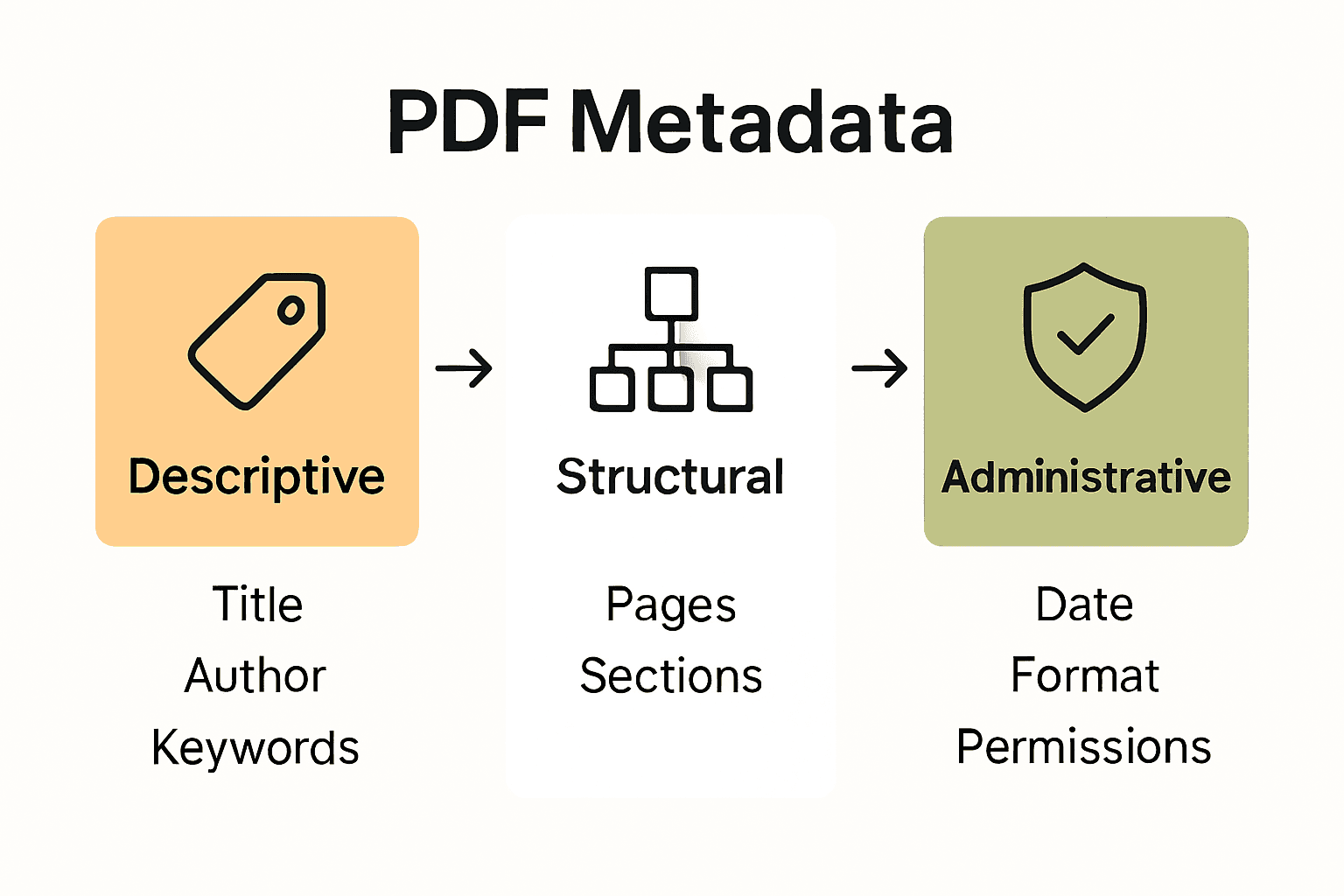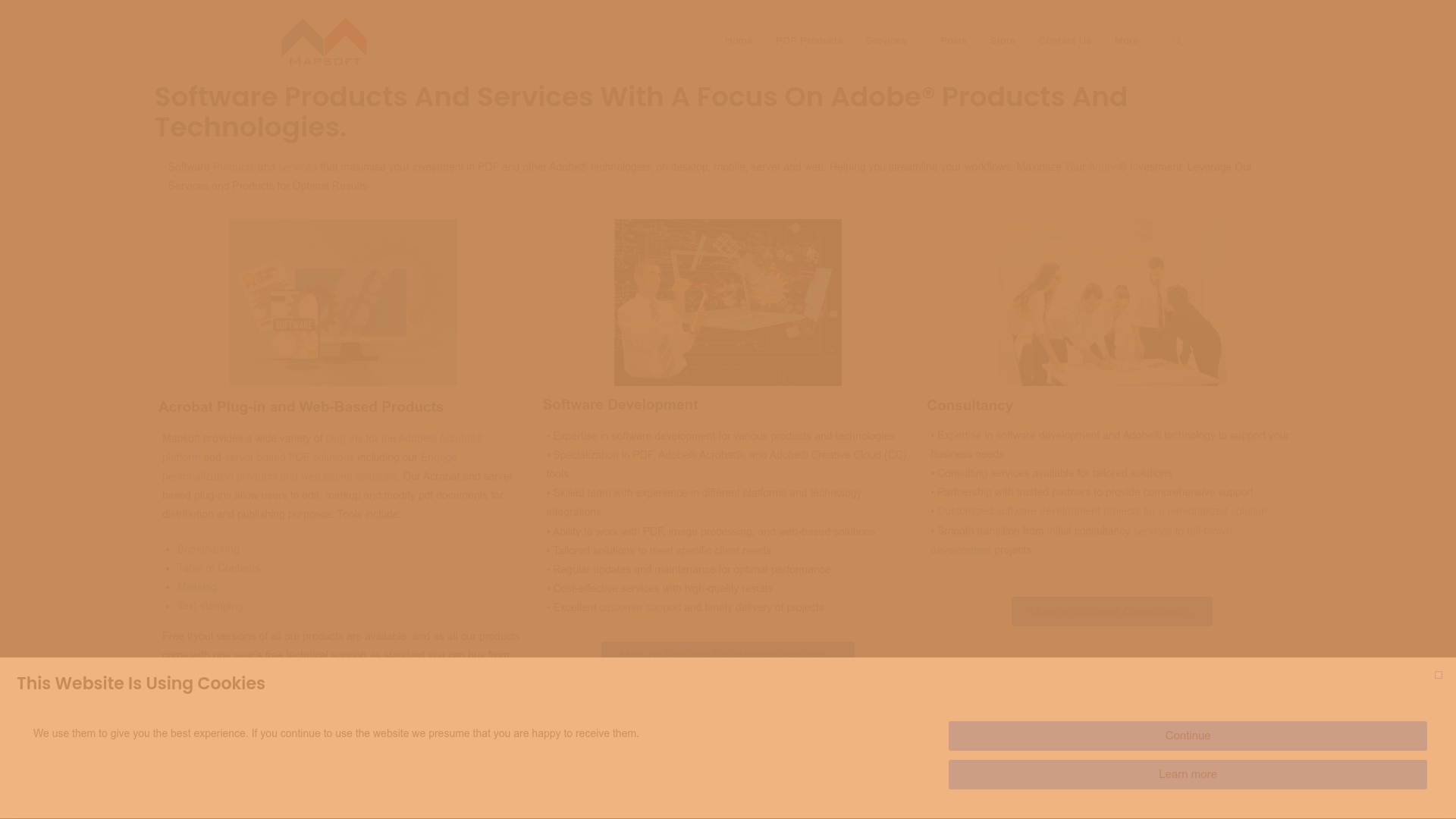Did you know that more than 80 percent of business data is unstructured and often hard to find? Metadata acts as the silent organizer behind digital information, helping companies locate, manage, and protect valuable files every day. With digital recordkeeping growing more complex, understanding metadata brings clarity and control to information chaos. This guide uncovers how metadata powers discovery, improves security, and drives smarter business decisions.
Key Takeaways
| Point | Details |
|---|---|
| Metadata Definition | Metadata is crucial for organizing, discovering, and managing digital information effectively, acting as a descriptor for data. |
| Metadata Types | In PDF workflows, metadata falls into three categories: Descriptive, Structural, and Administrative, each serving distinct functions to enhance document management. |
| Business Benefits | Effective metadata management enhances compliance, operational efficiency, and decision-making capabilities across organizations. |
| Risks and Mitigation | Organizations should address common metadata risks by establishing consistent standards, conducting audits, and implementing centralized management strategies. |
Table of Contents
- Defining Metadata And Its Core Functions
- Types Of Metadata Used In Pdf Workflows
- Business Benefits Of Accurate Metadata Management
- Impacts On Security, Compliance, And Accessibility
- Common Metadata Risks And How To Avoid Them
Defining Metadata and Its Core Functions
Metadata is essentially the backstage pass to understanding data. According to Wikipedia, it’s defined as “data about data” – a concise description that packs a powerful punch. Think of metadata like a library card for digital information: it helps you discover, organize, and access resources by providing critical context and details about the underlying data.

At its core, metadata serves several fundamental functions that make digital information manageable and meaningful. As research indicates, these core functions include:
- Discovery: Enabling users to find specific resources through attributes like title, author, or keywords
- Organization: Helping classify and categorize information systematically
- Identification: Providing unique markers that distinguish one piece of data from another
- Access Control: Managing permissions and defining who can view, modify, or interact with specific data
A metadata standard ensures consistency and interoperability across different systems. According to research from Wikipedia, these standards support accurate interpretation of data, especially in complex distributed environments. By establishing common semantics and meaning, metadata transforms raw information into actionable, intelligible resources that can be efficiently searched, shared, and utilized across diverse technological landscapes.
Types of Metadata Used in PDF Workflows
PDF workflows leverage multiple metadata types that transform how documents are managed, tracked, and understood. According to research from PurePDF, metadata in PDF documents encompasses a rich landscape of information that goes far beyond simple document properties.
These metadata types can be broadly categorized into three primary classifications:
Here’s a comparison of the primary types of PDF metadata:
| Metadata Type | Description | Main Examples |
|---|---|---|
| Descriptive | Identifies and summarizes document content | Title Author Subject Keywords |
| Structural | Defines document structure and relationships | Page order Bookmarks Table of contents |
| Administrative | Tracks document management and usage details | Creation date Permissions Version history |
- Descriptive Metadata: Includes key identifiers like title, author, subject, and keywords that help users quickly understand and locate documents
- Structural Metadata: Defines how document pages are ordered, organized, and interconnected within the PDF
- Administrative Metadata: Tracks critical background information such as creation date, modification timestamps, access permissions, and version history
Specifically in PDF workflows, metadata often incorporates advanced schemas like XMP (Extensible Metadata Platform), which supports complex metadata frameworks. According to Wikipedia, these schemas can include specialized namespaces such as Dublin Core, Adobe PDF schema, and custom rights management configurations. This rich metadata ecosystem enables precise document tracking, enhances searchability, and provides granular control over document properties and access in enterprise document management systems.
Business Benefits of Accurate Metadata Management
Metadata management transforms raw information into a strategic business asset that drives efficiency and insights. According to research from DataGalaxy, metadata supports critical business functions by tracking document lifecycles, enhancing decision-making, and enabling seamless integration across complex technological ecosystems.
The strategic advantages of precise metadata management are profound and wide-ranging:
- Compliance and Security: Enables granular tracking of document access, user interactions, and lifecycle stages
- Decision Support: Adds rich contextual information that transforms raw data into actionable intelligence
- Operational Efficiency: Facilitates rapid document retrieval, archiving, and migration processes
- Governance Enhancement: Supports automated policy enforcement and standardized information management
Research from EW Solutions highlights that accurate metadata management goes beyond simple record-keeping. It strengthens organizational responsiveness by creating centralized, consistent data repositories that improve IT scalability, support strategic decision-making, and provide a robust framework for managing increasingly complex digital information landscapes. By treating metadata as a strategic resource, businesses can unlock unprecedented levels of operational transparency, compliance, and technological agility.
Impacts on Security, Compliance, and Accessibility
Metadata management plays a critical role in safeguarding digital assets and ensuring organizational integrity across complex information landscapes. According to research from DataGalaxy, metadata provides a robust mechanism for tracking user access, monitoring data changes, and enforcing lifecycle policies that are essential for maintaining security and compliance.
The multifaceted impacts of metadata extend across three critical domains:
- Security: Enables granular access controls, tracks document interactions, and identifies potential unauthorized modifications
- Compliance: Supports regulatory requirements by creating transparent audit trails and maintaining precise documentation standards
- Accessibility: Ensures documents can be properly interpreted, searched, and used by diverse users and assistive technologies
By implementing comprehensive metadata strategies, organizations can create a proactive defense mechanism that goes beyond traditional security approaches. Metadata becomes more than just descriptive information—it transforms into an active guardian of organizational data, providing real-time insights into document usage, preventing potential security breaches, and ensuring that sensitive information remains protected while remaining accessible to authorized personnel. Learn more about document security guidelines to understand how metadata serves as a crucial line of defense in modern digital ecosystems.
Common Metadata Risks and How to Avoid Them
Metadata management isn’t without its challenges. According to research from Pure Storage, organizations frequently encounter significant risks that can compromise data integrity, privacy, and operational efficiency.
The most prevalent metadata risks include:

- Inconsistent Standards: Lack of uniform metadata guidelines across different systems and departments
- Privacy Vulnerabilities: Potential unintended information disclosure through embedded document metadata
- Quality Degradation: Insufficient metadata maintenance leading to poor discoverability and search capabilities
- Security Gaps: Neglecting metadata’s role in tracking document interactions and access
According to Privacy Insights, mitigating these risks requires a proactive, multifaceted approach. Organizations should implement centralized metadata management, establish clear standards, conduct regular metadata audits, and develop comprehensive templates that balance information richness with privacy protection. Explore our document security guidelines to understand how strategic metadata management can transform potential risks into robust organizational safeguards.
Unlock the Full Power of Metadata with Mapsoft PDF Solutions
Are you struggling to keep your PDFs organized, compliant, and secure? As explained in “The Essential Guide to Why Metadata Matters,” issues like inconsistent metadata, privacy risks, and inefficient workflows can slow your team down and leave your organization exposed. Whether you need better discovery, stronger compliance, or simple batch updates to PDF metadata, your business deserves tools that make these challenges easy to overcome.

Experience how the Mapsoft PDF Hub puts you in control of every document. Analyze and manage metadata with precision across your entire PDF library. Automate complex workflows and secure vital documents with just a few clicks. Take the next step and see how Mapsoft.com can help you turn metadata management into your competitive advantage. Act now to modernize your document processes and protect what matters most.
Frequently Asked Questions
What is metadata and why is it important?
Metadata is “data about data” that provides context, enables discovery, and organizes information effectively. It’s essential for effective data management, allowing users to find, access, and utilize digital resources efficiently.
What are the main types of metadata used in PDF workflows?
The main types of metadata in PDF workflows include descriptive metadata (like title and author), structural metadata (which organizes pages and documents), and administrative metadata (which tracks document management details like permissions and creation dates).
How does metadata management improve security and compliance?
Effective metadata management enhances security by enabling granular access controls and tracking document interactions. It also supports compliance by providing transparent audit trails and maintaining documentation standards required by regulations.
What are common risks associated with poor metadata management?
Common risks include inconsistent standards across systems, privacy vulnerabilities due to embedded data, degraded quality leading to poor searchability, and security gaps resulting from neglecting metadata’s tracking capabilities.



